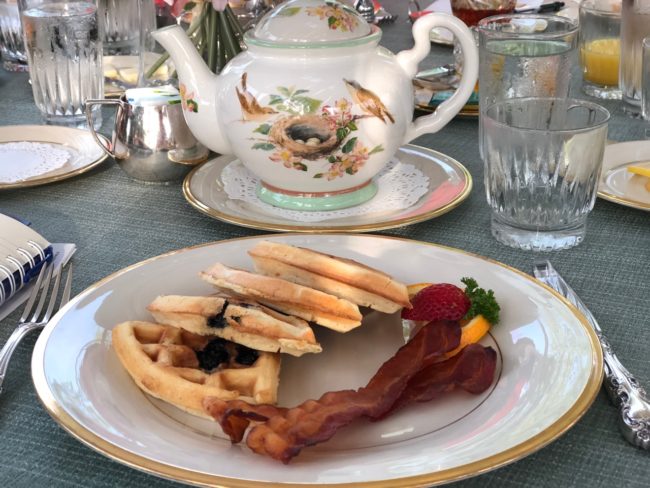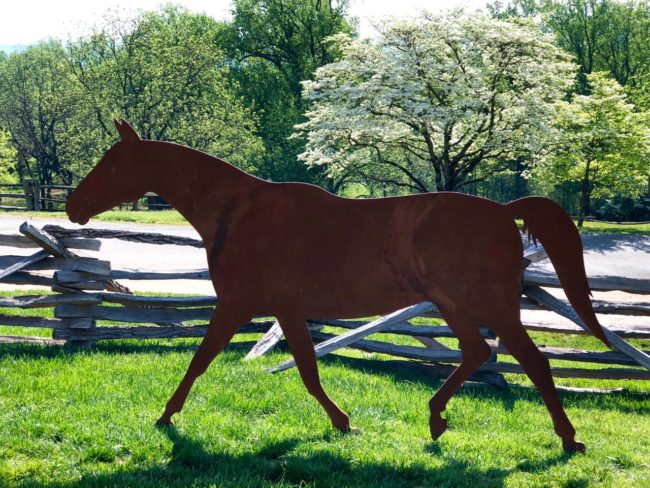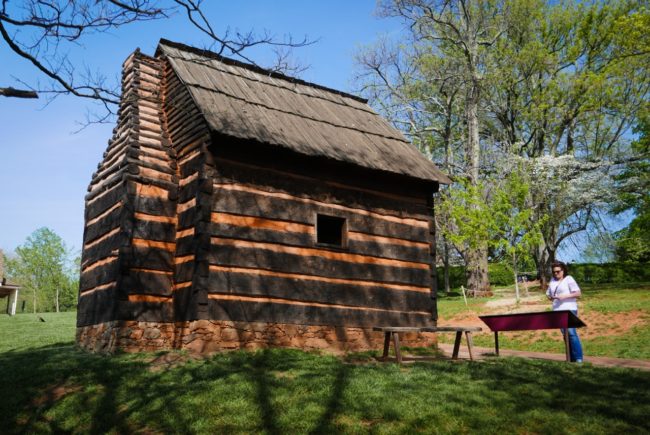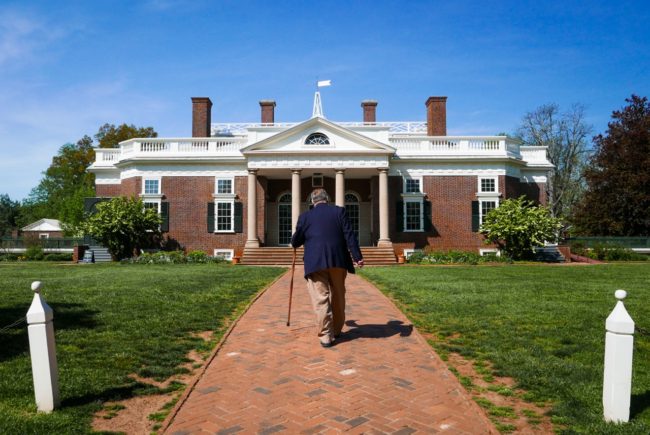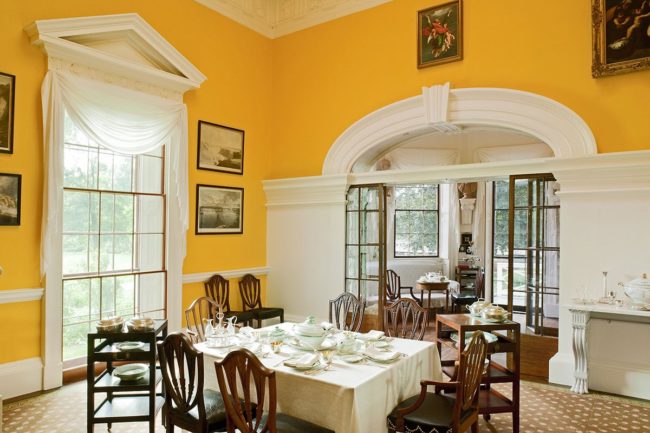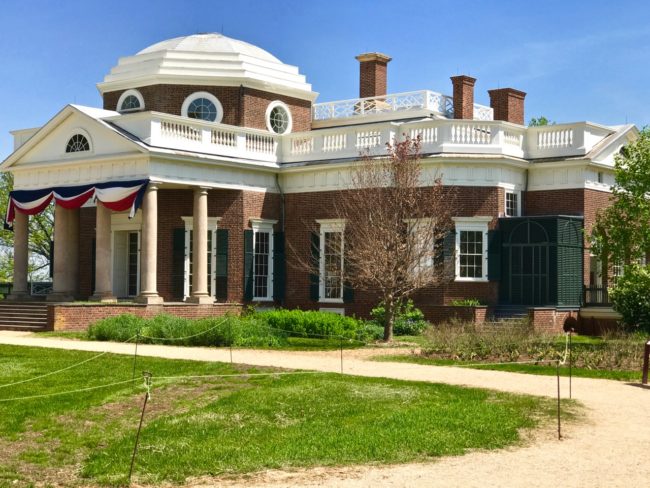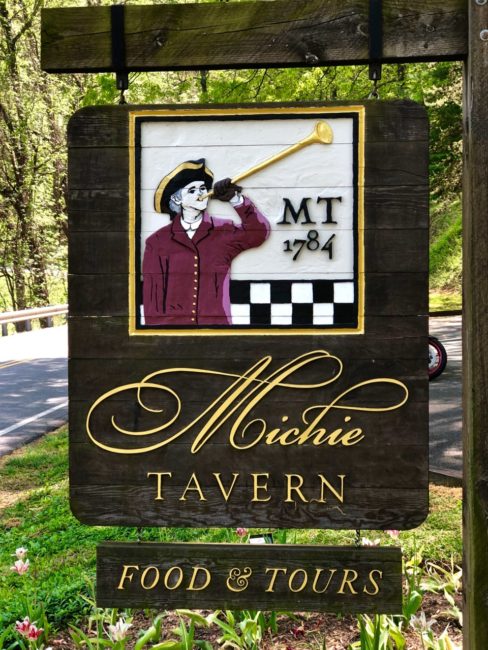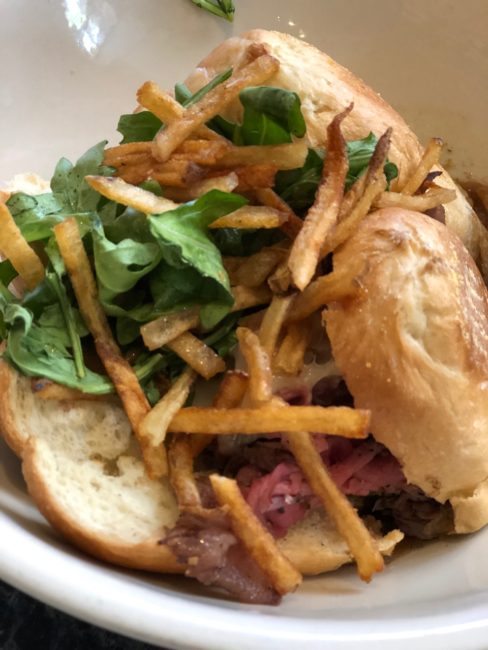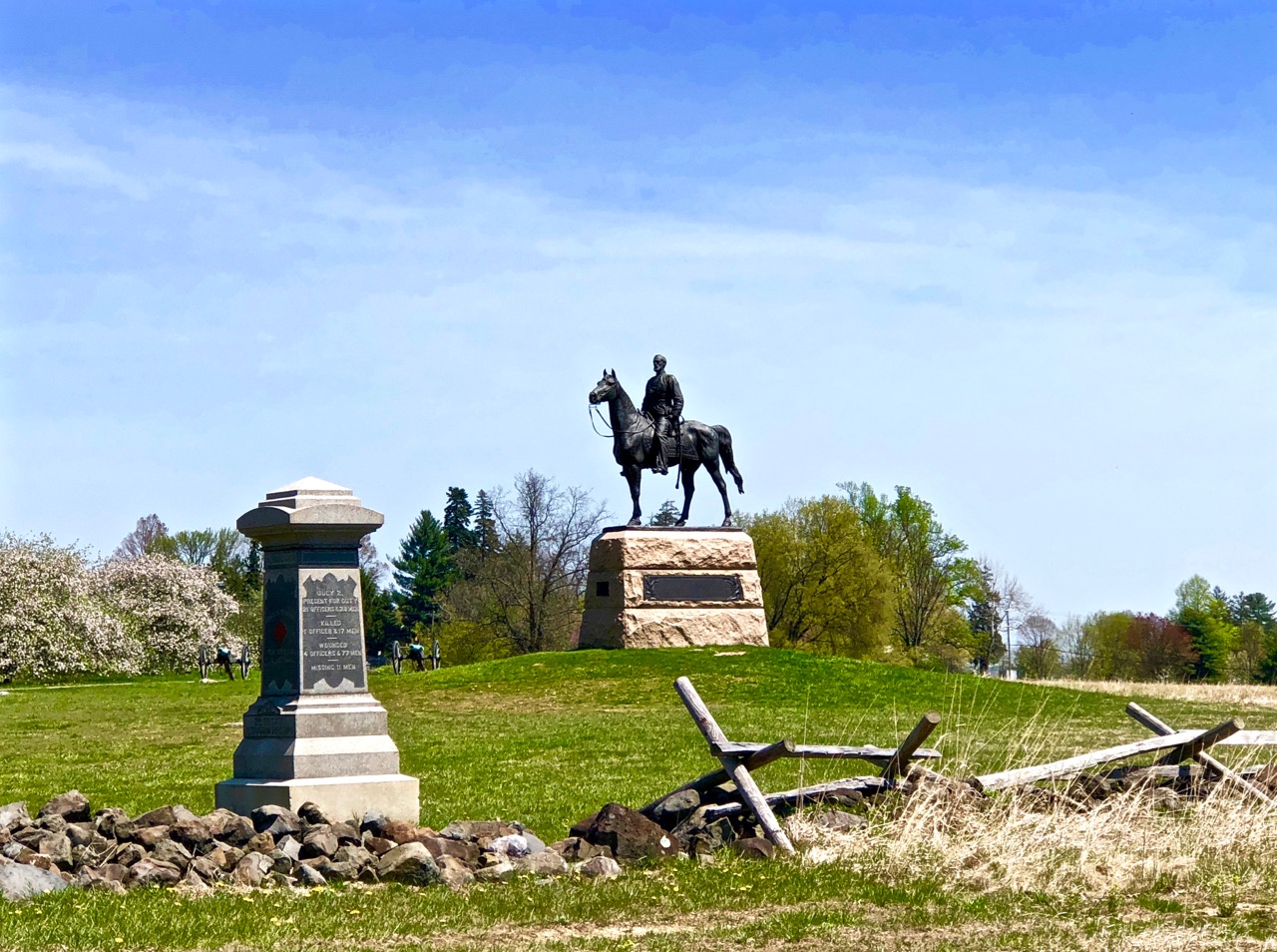
Chapter Six: The Battle Of Gettysburg
July 2, 2018
Chapter Eight: From Founding Fathers To Founding Farmers
July 25, 2018Mai Tai Tom’s Magical History Tour
Chapter Seven: Presidents Day
Day Seven – Waffling, Tom & Tom, Terrific Tour, Kids Ask The Darndest Things, Jefferson’s Coffee Addiction, Ash Lawn Or Highland, Payne In The Ass, Hush Hush Sweet Charlottesville, Can Never Get Enough Hamilton, Contentious Grounds, The Hills Are Not Alive, Orange On The Way To Orange, Ooh It’s A Holladay and The Odd Couple
The Inn at Old Virginia does not usually serve their delicious breakfast until 8:30 a.m., but they nicely opened their doors a half hour early when we told them we were visiting a nearby president’s home at a certain time. And, oh, what a breakfast it turned out to be. If you have the opportunity to visit this area, be sure to stay here. You won’t regret it.
It’s a beautiful, short walk to the breakfast room. We admired the country side surrounding us, but the breakfast room beckoned.
The owner of the inn, Eve, seated us at a table in the English-style glass conservatory that had a view overlooking the vast, green landscape. We started with a home-made granola parfait with the best raspberries (from California, of course) I have ever tasted. I am not a granola guy, but this was out of this world. Mary asked if she would share the granola recipe, and (not in these exact words) Eve said she could, but she would have to kill her. Mary ended up buying some granola at the inn’s boutique instead.
Next up were blueberry waffles with bacon. Sufficiently satiated …
… after a couple of more photo ops, the crew hit the road in search of presidential residences.
First stop: Monticello, home of our third president, one Mr. Thomas Jefferson. You are supposed to arrive 45 minutes before your timed reservations, because there is a short bus ride from the Visitors Center up to the residence. Of course, thanks to our anal leader (aka me), we arrived even earlier.
After getting our UNESCO card stamped (I’m telling you someone should come up with that), Mary and I paid our respects to Tom (the other Tom) …
… and then we hopped on the bus for the quick trip to the instantly recognizable house. Speaking of UNESCO, Monticello is one of only a few structures in the United States to be designated as UNESCO sites (including Independence Hall, which we visited on this trip).
As it turned out, it was good to be early (at least that’s what I told our crew) since we had time to walk around on this already scorching morning and check out the vegetable gardens where TJ grew 330 different varieties of veggies.
They also grew 170 fruit varieties somewhere on the vast property, but it was all vegetables for us on this morning.
I guess they had no problem getting their 5 A Day.
Not one to horse around, we also visited the stables.
I told Tracy that was one skinny horse. She replied, “It’s not real.” I knew I needed more sleep.
As we walked further, we came upon a cabin called Hemming’s Cottage, which may have housed John Hemmings (woodworker) and his wife Priscilla, nurse to Jefferson’s grandchildren. This reconstructed slave cottage was “more comfortably furnished than typical slave dwellings.” Living next door at times were other family members, including Sally Hemings. (I don’t know why she only has one “m” in her last name.)
During our tour, the guide did not shy away about Jefferson owning slaves. The Founding Fathers were conflicted on this issue; wanting slavery to be abolished, yet owning slaves themselves. They talked the talk, but, for the most part, didn’t walk the walk on the slavery issue as none of the Founding Father presidents we learned more about on this trip were good about freeing their slaves. Jefferson alone owned 600 slaves. Several slaves were whipped at the hands of Monticello overseers. Jefferson only freed seven slaves, mostly of which were his children from Sally.
Jefferson had six children with his wife Martha; and five with Sally Hemings (after Martha died). Jefferson was widowed after 10 years of marriage and never remarried.
Luckily this tree is secured or we’d hear “Timberrrrrrr!” And, we also took a look at our view out over the veggie garden.
We were met by our informative docent who took us to some of the rooms in this 11,000 square-foot home that sits on 5,000 acres of land. Jefferson inherited this huge property from his father and spent a great deal of his life designing (and redesigning) Monticello, once stating, “Architecture is my delight.”
This was actually the second home he designed, and it was virtually finished during the last year of his presidency in 1809.
There are no photos allowed inside, so the few I have added to this report are courtesy of Monticello.
The room where we entered is filled with Jefferson’s collection of Native American shields, weapons and other artifacts brought back by Lewis and Clark, plus there’s a two-sided clock Jefferson invented.
His bedroom includes an alcove bed, which divided the study from his bedchamber, so when he awoke he could immediately go to work.
Jefferson died on July 4, 1826, 50 years after the Declaration of Independence. According to Jefferson’s physician, his last words were, “Is it the Fourth?” His last recorded statement was, “ No doctor, nothing more.” As most people know, Jefferson and his buddy, second President of the United States John Adams, died on the same day. Adams last words were, “Thomas Jefferson still survives,” which was incorrect since Jefferson died five hours before Adams.
Our guide said that statement segued into his favorite question from one of the children who took the tour with his classmates. When our guide told the kids that Adams didn’t know that Jefferson was already dead, the child inquired to our guide, “Why didn’t someone call him?”
Inside, there is a famous portrait of Jefferson painted by Gilbert Stuart. It is co-owned by the Portrait Gallery in Washington DC, and the painting goes back and forth every three years.
A couple of fun facts … it seems Jefferson loved ice cream, and he was one of the first Americans to serve ice cream. He was also one of the first to serve his guests Mac & Cheese, along with French Fries. I mean he did hang out in France for a long time. Here’s a scoop … Jefferson created the first known ice cream recipe by an American. He and his guests might have eaten those goodies right here in the dining room.
It’s too bad Starbucks wasn’t around back in Jefferson’s day. Our guide told us he drank one pound of coffee per day, which I assume meant he didn’t sleep much. The entire tour takes about half an hour.
Downstairs Jefferson’s Wine Cellar was on view. His love affair with wine really started during his time in France when he was the first ambassador to France. He was also adept at wine pairing. Jefferson had a dumbwaiter installed next to the fireplace in the dining room so that he could send empty bottles to the cellar for fresh ones. He would open about 400 bottles a year (that seems about right).
We also checked out the recreated kitchen where slaves cooked the food.
Back outside we walked around back to the view that most people equate with Monticello.
The tulips were blooming, but in this heat I don’t think they could have lasted long. The trees here also filled the landscape with color.
They were preparing for a big shindig. Our invitation must have been lost in the mail.
The day was getting brutally hot, but we made the short walk down a trail to the small cemetery (The Monticello Graveyard).
Buried here are Jefferson and many of his descendants. His tombstone reads …
“Here was buried
Thomas Jefferson
Author of the Declaration of American Independence
of the Statute of Virginia for religious freedom
& Father of the University of Virginia.”
Being the father of the University of Virginia, you’d think he would have a more Cavalier attitude.
He made sure that the monument was built with “coarse stone … that no one might be tempted to destroy it for the value of the materials.” However, it’s not the one shat stands here now. In 1883 the United States government erected a larger one that covers the graves of Jefferson, Martha, his two daughters (by Martha) and his son-in-law, Governor Thomas Mann Randolph.
The graveyard is an interesting story in itself. When Jefferson was a young guy, he and his childhood friend Dabney Carr agreed they would be “buried under a great oak tree which stood here.” Carr, who married Jefferson’s sister died in 1773, and was the first to buried here.
The journey to our next president’s residence took only a few minutes. Soon we were at James Monroe’s Highland (formerly Ash Lawn). Unlike Monticello, you do not need advance reservations to visit here. Tickets are 14 bucks with one dollar off with an AAA membership and two dollars off if you’re of a certain age … like me. The tree-lined driveway up to the Visitor’s Center is actually one of the highlights of the visit.
Monroe’s original home burned down in the mid 1800s. A later owner of the land dubbed it Ash Lawn, but it has since reverted to the original name (Highland) that the Monroes gave it. Right now, there is excavation work to uncover the Monroe’s main home, which was relatively recently discovered. (An archeological dig found the foundation).
Walking though the garden, we spied Monroe’s statue.
We strolled around the grounds for a bit, before the 50-minute tour started.
We learned a lot about the property and the excavation project as we stood in the heat. Once again, our tour guide was terrific.
It was time to enter Monroe’s guest house which is still standing. Again, no photos inside. I hate that!
We were regaled with Monroe facts and stories. It seems his wife, Elizabeth, was quite the fashionista. When Monroe was the Ambassador to France, Elizabeth visited Lafayette’s wife, who was imprisoned after the French Revolution and the Reign of Terror. Our guide told us that Elizabeth was instrumental in getting her released from prison, although that fact has only been mentioned in a biography of James Monroe.
What’s definitely true is that James Monroe did secure the jail release of Thomas Payne, author of Common Sense. Payne was so sick that Monroe invited him to stay at Highland … under one condition? Payne could not say anything ill about George Washington, or he’d get the boot.
At one point it’s safe to assume that Monroe hoped Payne would say something negative about Washington. Not using common sense, Payne would overstay his welcome by staying for 18 months, much to the Monroes consternation. Old Thomas proved to be the literal “Payne in the ass.”
Monroe became the third president to die on the 4th of July, joining Adams and Jefferson, albeit it was five years later. No, he didn’t phone anyone either.
Monroe Fun Facts: He was the only United States citizen to attend Napoleon’s coronation, and the first president to ride in a steamboat.
He was also the youngest Founding Father and one of three presidents to Fight in the Revolutionary War. Wounded at the Battle of Trenton, a musket ball remained in his shoulder for the rest of his life.
It was time for lunch. I had looked forward to a lunch at Michie Tavern, an historic restaurant that was established in 1784. There’s no doubt it’s a cool-looking building, but inside we learned that meals are served buffet-style, with only fried chicken as a choice on this day. We declined.
It was off to downtown Charlottesville in search of a good meal. Checking which restaurant was closest to our locale and garnered decent reviews, the name Hamiltons’ came up. After singing a few numbers from the play, we parked and walked to the pedestrian street where Hamiltons’ at First & Main was located. It turned out to be a great choice.
 Our late lunch included the Blue Plate Veggie Special, a deconstructed French Dip (Kim said it was delicious) and Pimento Cheese Hush Puppies.
Our late lunch included the Blue Plate Veggie Special, a deconstructed French Dip (Kim said it was delicious) and Pimento Cheese Hush Puppies.
Throw in Fettuccini with Sausage (very good) along with Shrimp & Grits, and we all came away very happy. Yes, we were very hungry!
It was now time to find the park with the statue that caused all the commotion and controversy in Charlottesville just about one year previously. Located in Emancipation Park, the statue of Robert E. Lee, dedicated in 1924, shows Lee astride his horse, Traveller. In stark contrast to the hundreds who congregated here in May 2017, today the statue stood in the near empty park with an orange barrier. By the way, the humidity by now was becoming oppressive.
When we were at Monroe’s Highland, we were told to visit nearby Carter Mountain (not named after Jimmy) for great views of the valley. Unfortunately when we reached the top, the haze was so bad, the views were not stellar.
Back down the hill we traveled, and en route to Orange, coincidentally, we saw a sign for the Trump Winery. “Hey, it’s Orange on the way to Orange,” I said. The group might have given me grief, but I couldn’t hear them over a cough I had developed that was getting worse by the minute.
We arrived in Orange in the late afternoon for our overnight stay at the Holladay House (photo from internet … my cough made me even more unsteady and others were running for cover). This lovely b&b has been an historic landmark since 1830. Sadly, my cough made me feel about 180, so we decided to stay in while Kim and Mary went out to dinner.
Thankfully the Holladay House had a window air conditioner that cooled us off (photo from internet is actually our room compete with the air conditioner that saved my life). Plus, since we didn’t have dinner, that meant I could devour breakfast that the inn provided the next morning.
Kim and Mary dined at nearby Fork, which had been recommended by our gracious hostess and inn owner, Sharon. They spent the next few hours talking with what they dubbed “The Odd Couple,” who they said were very nice. Kim and Mary gleaned that the gentleman was an assistant chef in Nixon’s White House, owns restaurants, loves Spain and disdains Italian food.
Meanwhile back at the inn, after taking a quick trip to the local pharmacy we spent the night in our room. We dined on some of Sharon’s delectable home-made, chocolate cookies, which reminded me of our “Pringles dinner” in a Rome hotel one night, although the b&b’s cookies we dined on were much, much better. I can attest to that because I ate a lot of them.
Tomorrow, I would rally, and the motley crew would regroup to check out one more presidential residence. We followed that up with a quick stop (very quick, much to someone’s consternation) at another battleground before heading to Washington DC, where we’d rush to the Portrait Gallery to view a couple of newly installed famous paintings.
Chapter Eight: From Founding Fathers To Founding Farmers
Day Eight – Please … No Monty Python Reference, Home James, Hello Dolley, Better Than Monticello?, It’s A Small World, Tracy’s Pen Goes Wild, A Farewell To Arm, The Lone Ranger, The President & First Lady, A Nice Place For A Cocktail and Any Port (or White Wine) in a Storm




